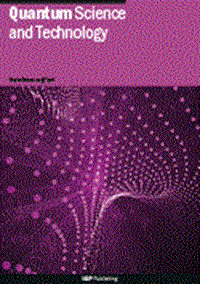Synthesis of energy-conserving quantum circuits with XY interaction
IF 5.6
2区 物理与天体物理
Q1 PHYSICS, MULTIDISCIPLINARY
引用次数: 0
Abstract
We study quantum circuits constructed from gates and, more generally, from the entangling gates that can be realized with the XX + YY interaction alone. Such gates preserve the Hamming weight of states in the computational basis, which means they respect the global U(1) symmetry corresponding to rotations around the z axis. Equivalently, assuming that the intrinsic Hamiltonian of each qubit in the system is the Pauli Z operator, they conserve the total energy of the system. We develop efficient methods for synthesizing circuits realizing any desired energy-conserving unitary using XX + YY interaction with or without single-qubit rotations around the z axis. Interestingly, implementing generic energy-conserving unitaries, such as CCZ and Fredkin gates, with two-local energy-conserving gates requires the use of ancilla qubits. When single-qubit rotations around the z-axis are permitted, our scheme requires only a single ancilla qubit, whereas with the XX+YY interaction alone, it requires two ancilla qubits. In addition to exact realizations, we also consider approximate realizations and show how a general energy-conserving unitary can be synthesized using only a sequence of gates and two ancillary qubits, with arbitrarily small error, which can be bounded via the Solovay–Kitaev theorem. Our methods are also applicable for synthesizing energy-conserving unitaries when, rather than the XX + YY interaction, one has access to any other energy-conserving two-body interaction that is not diagonal in the computational basis, such as the Heisenberg exchange interaction. We briefly discuss the applications of these circuits in the context of quantum computing, quantum thermodynamics, and quantum clocks.具有 XY 相互作用的能量守恒量子电路的合成
我们研究由门构造的量子电路,更广泛地说,是由仅通过 XX + YY 相互作用就能实现的纠缠门构造的量子电路。这种门保留了计算基础中状态的汉明权重,这意味着它们尊重与绕 Z 轴转动相对应的全局 U(1) 对称性。等效地,假设系统中每个量子比特的内在哈密顿是保利 Z 算子,它们就能保持系统的总能量。我们开发了高效的方法,利用 XX + YY 相互作用(无论是否存在绕 Z 轴的单量子比特旋转)合成电路,实现任何所需的能量守恒单元。有趣的是,使用双局域能量守恒门实现通用能量守恒单元(如 CCZ 门和 Fredkin 门)需要使用 ancilla 量子位。当允许围绕 Z 轴进行单量子比特旋转时,我们的方案只需要一个 ancilla 量子比特,而如果仅使用 XX+YY 相互作用,则需要两个 ancilla 量子比特。除了精确实现外,我们还考虑了近似实现,并展示了如何只用一串门和两个辅助量子比特就能合成一般的能量守恒单元,而且误差可以任意小,并可通过索洛维-基塔耶夫定理对误差进行约束。我们的方法也适用于合成能量守恒单体,当我们可以利用计算基础中不对角的任何其他能量守恒双体相互作用,如海森堡交换相互作用,而不是 XX + YY 相互作用时。我们简要讨论了这些电路在量子计算、量子热力学和量子钟方面的应用。
本文章由计算机程序翻译,如有差异,请以英文原文为准。
求助全文
约1分钟内获得全文
求助全文
来源期刊

Quantum Science and Technology
Materials Science-Materials Science (miscellaneous)
CiteScore
11.20
自引率
3.00%
发文量
133
期刊介绍:
Driven by advances in technology and experimental capability, the last decade has seen the emergence of quantum technology: a new praxis for controlling the quantum world. It is now possible to engineer complex, multi-component systems that merge the once distinct fields of quantum optics and condensed matter physics.
Quantum Science and Technology is a new multidisciplinary, electronic-only journal, devoted to publishing research of the highest quality and impact covering theoretical and experimental advances in the fundamental science and application of all quantum-enabled technologies.
 求助内容:
求助内容: 应助结果提醒方式:
应助结果提醒方式:


